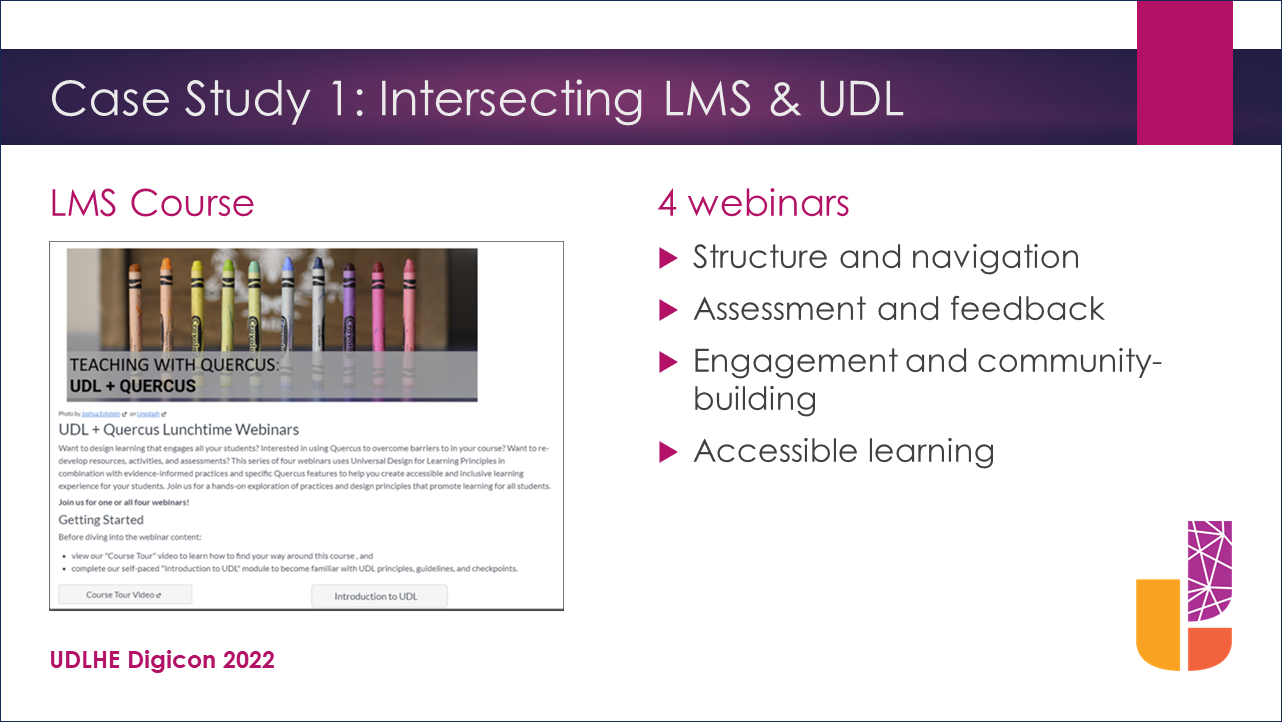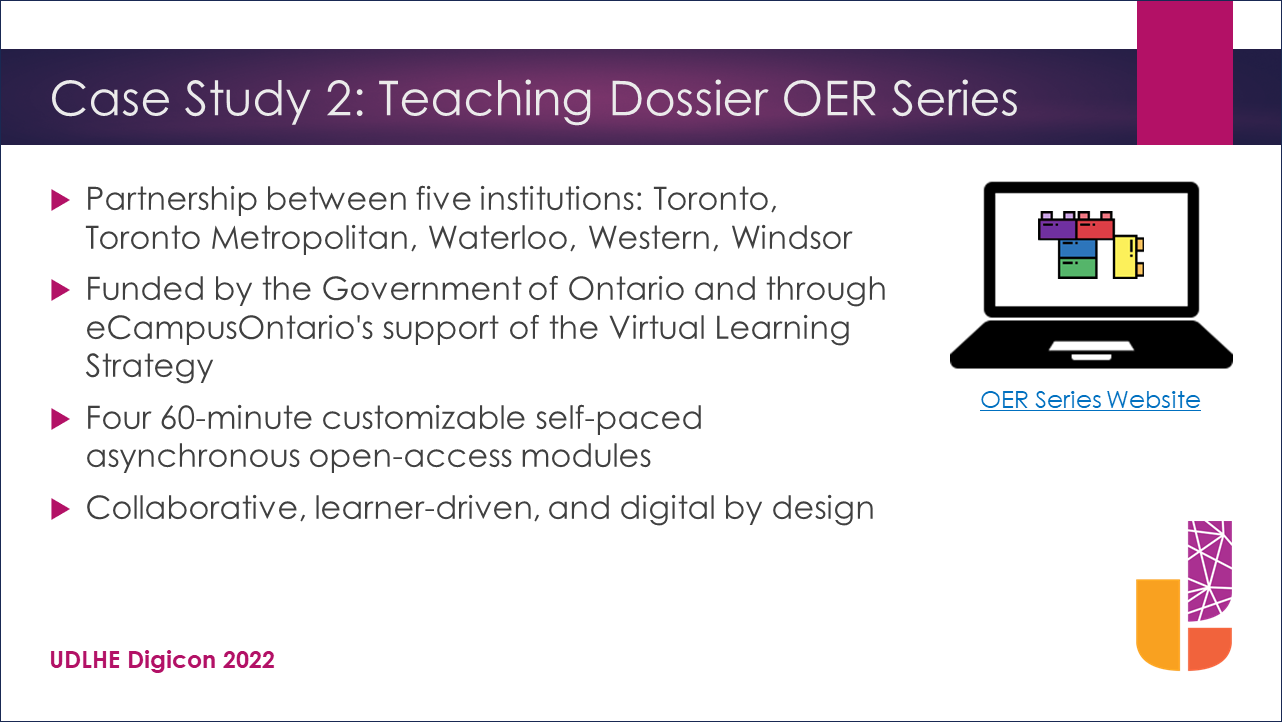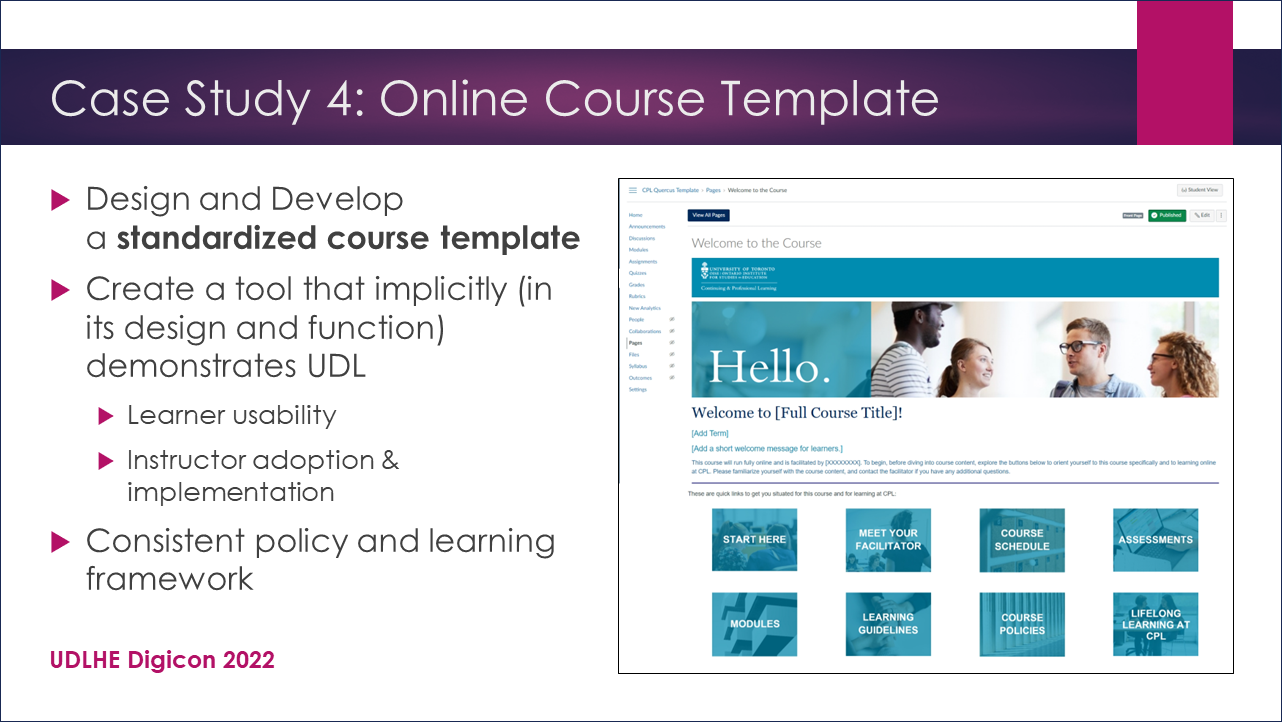On October 20, 2022, Michal Kasprzak, Samantha Chang, Gabriela Pawlus Kasprzak, and Anna Limanni co-facilitated a session at the UDLHE (Universal Design for Learning in Higher Education) Digicon 2022 conference. The session highlighted strategies for UDL implementation at the University of Toronto, through the lens of four specific case studies.
This blog post reviews the session: Implicit Design, Explicit Function: Educational Developers on UDL Implementation Strategy Continuum. It includes a brief summary of a novel UDL implementation approach and the 4 case studies used to illustrate this approach. The slide deck used for the session as well as a link to the session recording are included at the bottom of this post.
Jump to
- Meet the presenters
- The rationale: A new approach to UDL implementation
- The implementation: Four case studies
- Session slide deck and recording
- References
Meet the presenters
In their session Michal, Samantha, Gabriela, and Anna shared their experiences with UDL implementation in their work as educational developers working at distinct units at the University of Toronto:
- Michal (Mike) Kasprzak, Assistant Director, Centre for Teaching Support & Innovation (CTSI) / Teaching Assistants' Training Program (TATP)
- Samantha Chang, Faculty Liaison, Pedagogical Support, Teaching & Learning, Faculty of Arts & Science
- Gabriela Pawlus Kasprzak, Curriculum Development Coordinator, Continuing and Professional Learning, OISE
- Anna Limanni, Senior Educational Technologist, Academic Toolbox, Education Technology Office, Faculty of Applied Science and Engineering
The rationale: A new approach to UDL implementation
Universal Design for Learning (UDL) is widely accepted as a framework for removing barriers and enhancing learning experiences across Higher Education. Implementation of UDL strategies is often framed in terms of top-down (i.e., leadership-led) approaches (Hills, Overend & Hildebrandt, 2022) that assume that implementation proceeds through a continuum of practices, along a linear trajectory (UDL-IRN & CAST, 2021). However, effective implementation of UDL strategies does not always follow a clear path (Fovet, 2021).
In their session, the presenters shared their experience of UDL implementation as fluid, dynamic, iterative, non-linear, and led from the bottom (typically by educational developers and accessibility services, in the absence of leadership buy-in and support). A more traditional, idealized approach views UDL implementation as a smooth path, with a single entry point and clear direction. In practice, we enter this 'forest' of implementation from variety of entry points and make our way through in a non-linear fashion, encountering many uncertainties along the way.
The goal of the presentation was to enhance the traditional framing of implementation along top-down or bottom-up approaches, and instead, map implementation strategies (encompassing both design and function) along an implicit-explicit continuum:
The implementation: Four case studies
The four case studies shared by the presenters illustrate how the moment when you can be explicit about UDL design and/or function can vary from project to project and highlight the different ways that UDL implementation can unfold. For all the cases studies, the presenters reflected on and engaged the audience in a conversation on ways to respond to challenges faced by UDL implementation advocates in Higher Education.
Case Study 1: Intersecting LMS & UDL: Onboarding Faulty to the New Institutional LMS (Anna)

- Project Summary: A Quercus course and 4 accompanying webinars highlighting LMS (Quercus) tools and features that support implementation of UDL principles. The webinars covered high impact, low effort strategies for using these tools and features to make learning more accessible and inclusive.
- UDL Implementation Strategy Continuum: Explicit Design, Explicit Function
- Learn more about this project: Join the UDL + Quercus course (UTORid + login required)
Case Study 2: UDL and Asynchronous OER Learning: Developing Your Teaching Dossier Series (Samantha)

- Project Summary: A four module Open Access series for graduate students and postdoctoral fellows exploring strategies to reflect on their teaching and developing their teaching dossier. The series consists of four 60-minute, self-paced, asynchronous modules co-developed by five institutional partners. The customizable modules include 17 H5P interactive books, 41 YouTube videos, and 89 Pressbooks files. All module components embedded learner-driven principles from several learning design frameworks. This project was made possible with funding from the Government of Ontario and through eCampus Ontario's support of the Virtual Learning Strategy.
- UDL Implementation Strategy Continuum: From Implicit to Explicit Design and Function
- Learn more about this project: Visit the OER Series Website (Quercus Course)
Case Study 3: UDL in Mandatory Teaching Job Training: Pedagogical Training (Mike)

- Project Summary:A Teaching Assistant Training Program consisting of 11 asynchronous 1-hour modules, as well as 2 and 4 hour synchronous online and in-person sessions. Both the course content and the training delivery forms implicitly follow and explicitly reference UDL principles.
- UDL Implementation Strategy Continuum: From Implicit to Explicit Design
- Learn more about this project: Visit the TATP Job Training Website
Case Study 4: UDL Online Course Template: UDL Implementation in Continuing Education (Gabriela)

- Project Summary: A standardized LMS (Quercus) course template for online continuing education courses. The template uses UDL principles to improve course accessibility and provide a consistent course experience for students, while reducing instructor workload in course design and development.
- UDL Implementation Strategy Continuum: From Implicit to Explicit Function
- Learn more about this project: Contact Gabriela
Session slide deck and recording
To learn more about the presentation and the case studies presented:
- Review and download the PDF of the session slides: Implicit Design, Explicit Function: Educational Developers on UDL Implementation Strategy Continuum.
- Watch the session recording below:
References
- Fovet, F. (2021). Learning and Teaching Research Methods by Universal Design: A Practical Case Study. In Handbook of Research on Applying Universal Design for Learning Across Disciplines: Concepts, Case Studies, and Practical Implementation (pp. 188–205). IGI Global. https://doi.org/10.4018/978-1-7998-7106-4.ch010
- Hills, M., Overend, A., & Hildebrandt, S. (2022). Faculty Perspectives on UDL: Exploring Bridges and Barriers for Broader Adoption in Higher Education. The Canadian Journal for the Scholarship of Teaching and Learning 13 (1), 1–18. https://doi.org/10.5206/cjsotlrcacea.2022.1.13588
- UDL-IRN & CAST (2021). The UDL School Implementation & Certification Criteria: Full Criteria.
What's next for this team? You can catch them presenting virtually at the 2023 UDL-IRN International Summit (March 14 & 15, 2023)!